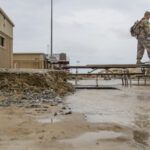Puerto Rico’s clean-energy and grid-restoration efforts still in doubt
By Jillian Melero | October 24, 2019
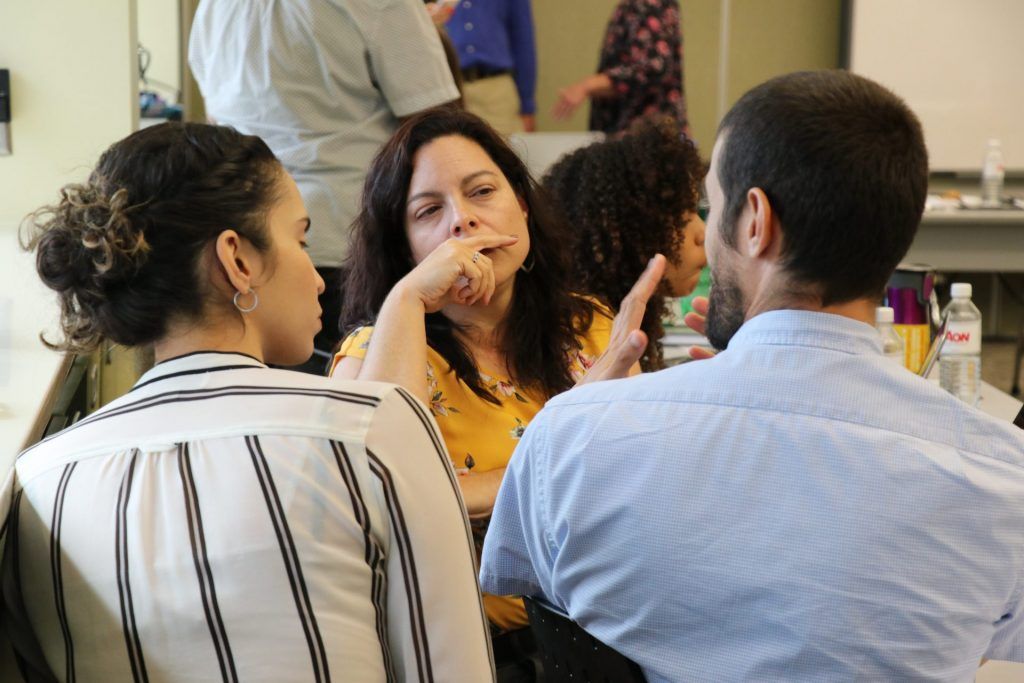 Marla Pérez Lugo and Marcel Castro Sitiriche speak with Elizabeth Angeles, a manager for the Clinton Global Initiative, during a meeting on energy workforce development at the Puerto Rico Manufacturer’s Association in Guaynabo, Puerto Rico. Photo by Jillian Melero.
Marla Pérez Lugo and Marcel Castro Sitiriche speak with Elizabeth Angeles, a manager for the Clinton Global Initiative, during a meeting on energy workforce development at the Puerto Rico Manufacturer’s Association in Guaynabo, Puerto Rico. Photo by Jillian Melero.
Editor’s note: This article was produced in partnership with Northwestern University’s Medill School of Journalism, Media, Integrated Marketing Communications.
For all its destruction in 2017, Hurricane Maria also was a catalyst for change that is long overdue on multiple levels: infrastructure, governance, and implementation. It’s change, however, that some fear will not come in time. Even though the island escaped the wrath of Hurricane Dorian, which devastated parts of the Bahamas this year, many fear the lessons learned from Maria could be forgotten and history will repeat itself. Ever-escalating hurricanes—their destructive energy fueled by warming oceans caused by climate change—make Puerto Rico, other islands in the Caribbean Sea and adjacent Atlantic Ocean, and the Atlantic coast of the United States increasingly vulnerable targets.
“The hurricane, we say here, did neutralize power. You had people from high positions with the same conditions as people from low positions,” said Joan (pronounced Joanne) Asencio Yace, a graduate student at the University of Puerto Rico who also works in community outreach for Resilient Power Puerto Rico. “They did not have access to energy; they did not have access to water. They did not have access to power [from] their own generators or to get their car going for more than two weeks. You had to [be in] the same line, you had to go through the same processes to get what you needed.”
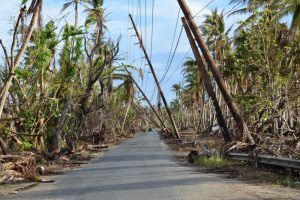
Hurricane Maria caused an estimated 2,975 deaths after slamming into Puerto Rico on Sept. 20, 2017. The failures of the electric power grid and other infrastructure took many of those lives. The death toll grew as the storm left vulnerable communities without electricity, without water, and without medical attention. The elderly and the poor suffered the most, but no one on the island was left untouched.
“All of a sudden you have everyone realizing, ‘Hey, there’s something that really needs to change in this nation,’” Asencio said, sitting on the front porch of her mountainside home in Mayagüez. “So how can that happen? Of course, it’s not just empowering the locals, it’s changing the whole umbrella of policies out there.”

The crumbled remains of apartment homes and resorts still litter Puerto Rico’s shorelines. But about 60 percent of the island is covered by mountains, and many of the people who reside in geographically isolated interior areas face constant challenges in receiving water or power from the main electrical grid—if they’re connected at all. Major roadways connecting beaches to mountains to rainforests are often cut off by flash floods, mudslides, and downed trees, in an environment where getting somewhere “on time” is more of a luxury than an expectation.
Puerto Rico has a new Public Energy Policy that shows promise, but only if the government and power authority actually put it into practice.
Clean energy policies … on paper. In April, Puerto Rico’s now-ousted governor, Ricardo Rosselló, signed the Puerto Rico Energy Public Policy Act, which aims in various ways to promote clean energy. It bans the operation of coal-fired electrical generation plants starting in 2028; institutes a maximum 90-day utility approval period for commercial and industrial solar projects greater than 25 kilowatts and less than 5 megawatts; establishes automatic interconnection to the grid for residential solar systems under 25 kilowatts; and exempts energy storage systems from sales taxes, the photovoltaics-focused PV magazine has reported.
But many Puerto Ricans are skeptical about the ability of the Puerto Rico Electric Power Authority (PREPA), the government-run utility, to hit the marks set by the law. They question whether the government will follow through with support for implementation of alternative energy programs, and whether there will be any consequences for failure to meet the clean energy goals set out in the new energy law.
Activist organizations, including Resilient Power Puerto Rico, want to see a transition from central power plants that feed into the main power grid to more robust, decentralized models that also emphasize alternative energy sources. They’ve been working to secure funding, to help with installation, and to train citizens to maintain community solar microgrids—localized networks of electrical grids that can store, generate, and transmit power independent of larger power stations. They would like to see this model adopted and supported by Puerto Rico’s government and PREPA as well.
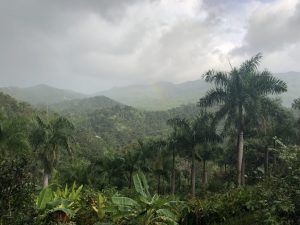
PREPA released an Integrated Resource Plan in February that contrasts sharply with the renewable- and consumer-friendly bill signed in April. PREPA’s plan relies heavily on liquefied natural gas (LNG), a resource that would need to be imported at high cost and that would require conversions of existing power plants.
Because the Jones Act, a federal law regulating maritime commerce, requires that all imports to Puerto Rico be carried by US-flagged ships, importing liquefied natural gas would also require the building of a new fleet of LNG transport-capable US ships. The Jones Act also requires such ships to be built in the United States and to be owned and operated by US citizens. The United States does not currently have any American-owned-and-operated ships capable of transporting LNG.
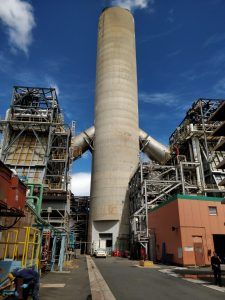
On June 10, PREPA released a new 2019–2038 resource plan, after Puerto Rico’s energy bureau ruled that the plan released in February did not comply with regulations. Since then, the plan has undergone several revisions and received repeated deadline extensions. As of September, the plan has yet to be finalized or approved, Utility Dive reported. Revisions of the plan include increased capacity for renewables but still maintain investment in and development of liquified natural gas capabilities.
Cecilio Ortiz García and Marla Pérez Lugo sit on their back patio as the sun sets. The sound of ocean breezes blowing through the palm trees is overtaken by the chirping of the coquis, the island’s tiny native frogs. Ortiz is an associate professor of political science at the University of Puerto Rico. He’s also on the steering committee of the Instituto Nacional de Energía y Sostenibilidad Isleña or National Institute of Energy and Island Sustainability. His research focuses on environmental and energy justice issues and governance.
Ortiz and his colleagues believe that Puerto Rico’s policymakers, businessmen, and investors are missing the point in their discussions about Puerto Rico’s energy future, looking for quick, affordable fixes that actually increase risks for low-income communities facing the added burden of climate change. They and Puerto Ricans in general have little voice in the planning or even the public hearings determining their fate.
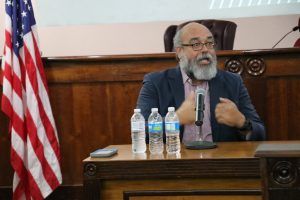
“Right now, what’s driving the energy [conversation] is ‘How are we going to introduce natural gas?—another fossil fuel that we do not have here in Puerto Rico [that] would require exactly what the current system wants, which is more investment, more capital investment on centralized plants, to bring about a growth on the books that will allow a company to get itself in debt again,” Ortiz said. “So energy in Puerto Rico is very much a political, economic, and social issue.” For Ortiz, natural gas is a distraction rather than a solution.
Another distraction has been the focus on management of the Puerto Rico Electric Power Authority. The power authority has been operating under a mountain of debt and is now moving toward privatization to help relieve some of that burden. But critics says privatization is not the answer, as PREPA has already operated like a privately run organization for years. And they fear that using privatization as a catch-all solution will only serve to undermine Puerto Rico’s chances of implementing a sustainable energy transition with the government’s support.
Building power from the bottom, up. Marcel Castro-Sitiriche is a professor of electrical engineering at the University of Puerto Rico. He’s also a Fulbright scholar who spent a year in Tanzania studying energy poverty, access to energy, and the technical and social systems involved in that phenomenon. What Castro saw in Tanzania was less reliance on microgrids and more focus on individual solar home systems to supply power to households in rural areas. He describes this as a “from the bottom up” model for developing a resilient power system – addressing the needs of those with the least access first, before devoting resources to large-scale transition plans. And it’s a model he thinks Puerto Rico needs.
“Nobody had power after the hurricane. It was ironic, because I had been working in rural electrification in Tanzania, and now the mountains of Puerto Rico needed to be re-electrified in a short time, because people were dying—mainly the poorest, the old,” Castro said.
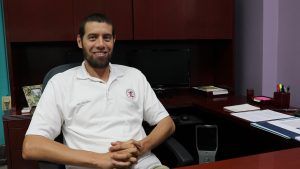
The severity of a blackout can be measured in terms of customer hours of lost electrical service; Castro calls them “CHoLES” (said in Spanish) for short.
“When we sum up all the blackouts because of Maria, it totals about [3 billion] hours of lost electrical service. That is a huge figure,” Castro said. “Before Maria, the biggest blackout in the US was about 1,000 million [1 billion] lost hours, and that was [Hurricane] Georges, also in Puerto Rico, in 1998. So now, 19 years later we broke our own record by three. And I hope we don’t break it again. I don’t think we should break it—we should get ready for the next one.”
Part of Castro’s research has been to break down how many households were out of power for how long.
A research report from Native Power Research Group, of which Castro is a part, found that the first 1 million customers accounted for 1 billion hours of lost electrical service, recovering power between September and November 2017. The next 300,000 customers recovered power between November 2017 and February 2018, contributing another 1 billion hours of lost service. The final group of 200,000 households didn’t regain power until sometime between February and August 2018, nearly a year after the storm. Those families endured 931 million hours of lost electrical service.
Castro believes that any transition policy or allocation of funds needs to start with these families—the 200,00 households in the most remote areas, which were out of power the longest. These are the people who will be the most vulnerable when the next storm comes. In June, Congress approved $19 billion of disaster aid to go to hurricane-, wildfire- and flood-affected regions, including Florida, Iowa, and Missouri. Of that, $1.4 billion will go to Puerto Rico. Castro estimates it would take about that much just to install home solar systems with batteries in those 200,000 homes. Castro’s plan suggests getting the funding from Community Development Block Grant Disaster Recovery funds and vouchers through the US Department of Housing and Urban Development.
“We need to focus on disaster preparedness or hazard mitigation,” Castro said. “How can we prepare for the next event, so that way it doesn’t become a disaster? Those remote areas that spent more than five months without electricity—I don’t see any other way to provide reliable electricity other than with solar panels and batteries, going from microgrids to solar systems … and here we have a potential to do that. If we are able to deploy hundreds of thousands of systems, for hundreds of thousands of families, then the landscape of energy will be very different, because what you could do with such a massive scale of distributed energy generation and energy storage, it’s really something that no other place in the world that I know has. We don’t have it either, but we have the potential to get there.”
Closed doors and a closing window. The Eugenio María de Hostos Airport in Mayagüez looks abandoned at first glance. It has one check-in desk, with one attendant and a few empty rooms. The control tower is partially collapsed. But Marla Pérez Lugo flies out of this airport often. For about $40, a 10-seat Cessna 402 will fly you to San Juan in 45 minutes, which is a preferable alternative to the 3-hour drive. And the views of the island are incredible. Pérez is a professor of environmental sociology at the University of Puerto Rico; she’s also on the steering committee of INESI, the national energy and sustainability institute. In April, Pérez testified before the House Committee on Natural Resources on the “rebuilding and privatization” of PREPA. Pérez is one of many experts who oppose the privatization of the electric power authority, an entity funded by and meant to serve the public.
“[PREPA] is the public corporation that is in charge of administering and managing the assets that belong to the people of Puerto Rico. I have been waiting for a lawyer to correct me on that, and I haven’t received any, so I will stick to it,” Pérez said. “The electrical system belongs to the people of Puerto Rico, and PREPA behaves as if PREPA owned the electrical system, which I think is wrong.”
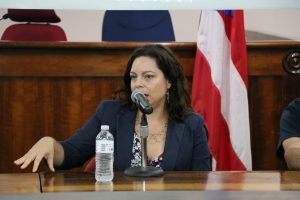
PREPA was first established in 1941 as the Puerto Rico Water Resources Authority, to ensure that citizens, even in the most remote areas, had access to water. As part of Franklin D. Roosevelt’s New Deal, PREPA evolved to develop and unify regional and local electrical power grids, officially changing its name to the electric power authority in 1979.
However, critics such as Pérez say that over time, PREPA lost sight of its original goal, which was to make sure that all Puerto Ricans, even the poorest and most isolated, had access to essential services like water and electricity. Instead, they say PREPA has become a political tool, catering to the will of the governor, who currently appoints six out of seven members of the PREPA board, and to the financial fortunes of special interests.
In her testimony to Congress in April, Pérez cited three main issues with the management of PREPA: lack of transparency, lack of accountability, and lack of real stakeholder representation. In her examples of such failings, Pérez recounted that during the Maria recovery efforts, PREPA first reported progress in terms of “percentage of clients reconnected” and then switched to “percentage of generation covered,” a change that Pérez said the Department of Energy found suspicious, causing it to drop PREPA’s updates from the department’s website. The change underscores what happened to thousands of people in remote areas of Puerto Rico.
In the weeks after Maria, Pérez recalled, PREPA announced that 200 communities in the mountain regions of Puerto Rico would not be reconnected to the power grid, based on a cost-benefit analysis. Such actions may be a reflection of the power authority’s leadership; PREPA’s board of directors, Pérez points out, is made up of seven members, just one elected to represent PREPA’s customers. According to 2014 bylaws, PREPA was required to have three members representing customer interests, but the requirement was changed under Governor Rosselló. To offset the appearance of impropriety, Pérez said, the governor created three additional committees to oversee PREPA’s activities. But again, the members of the committees are appointed, not elected.
Beyond board representation, Puerto Ricans are being shut out of the discussions on priorities for the energy transition and how it will impact them, Pérez said. There is no lack of panels, workshops, and conferences discussing Puerto Rico’s “new energy transition” or “green energy future.” But these meetings are typically held in metropolitan San Juan, Miami, or Washington D.C., making it difficult for rural residents to attend. And the meetings are usually conducted in English, a further barrier to many rural or low-income Puerto Ricans.
“The people that need the most to bring their experience and the experiences that we need most to enlighten our decision-making,” Pérez said, “are the ones that are being kept out systematically.”
Most of these conferences are sponsored by outside organizers and aimed at developers and investors; they often mention the opportunity for face time with government officials and corporate higher-ups and include a high price for admission. “They charge between $50 and $1,500 to get in. If you consider the people who died the most were people in the mountain region, with low income, low education, with health conditions, elderly—those are the same people that are being excluded from the discussions about what the electric future of Puerto Rico should look like,” Pérez said.
Philanthropic organizations such as the Clinton Foundation also have tried to aid the energy transition, holding free workshops to discuss workforce development and other economic recovery programs. But many of those meetings are geared toward government and trade organizations, are conducted predominantly in English, and are by invitation only.
“The result of a defective governance model that has no transparency, no accountability and no stakeholder representation is the absence of a clear mission for PREPA for the 21st century,” Pérez wrote in her testimony for Congress. “After 65 years of hierarchical, centralized, top down, and captured governance processes, how can a transition toward resilience and sustainability be enabled by a governance model that refuses to be transformed?”
The governmental mechanisms behind Puerto Rico’s rebuilding process are complicated and slow-moving. But the island has an opportunity to do more than rise—the island’s post-Maria rallying cry. Puerto Rico could truly transform itself in the wake of Hurricane Maria. But that transformation can only come from a careful collaboration between the communities most affected by the system’s current inadequacies and a government willing to lift citizens who need it the most.
“Maria, you could say, was a window of opportunity that helped in the convergence of some economic, political, and social ideas, so people talk about climate change because, look, these events are going to be more frequent and more extreme,” Ortiz said. “How much that maintains itself in the policy discourse remains to be seen. But if there are not readily prepared, mobilized collective actions in Puerto Rico to take advantage of those windows of opportunity, they will close, and we will go back to the same regime as before these events.”
Together, we make the world safer.
The Bulletin elevates expert voices above the noise. But as an independent nonprofit organization, our operations depend on the support of readers like you. Help us continue to deliver quality journalism that holds leaders accountable. Your support of our work at any level is important. In return, we promise our coverage will be understandable, influential, vigilant, solution-oriented, and fair-minded. Together we can make a difference.
Keywords: Hurricane Dorian, Hurricane Maria, Puerto Rico, electric grid, renewable energy
Topics: Analysis, Climate Change



